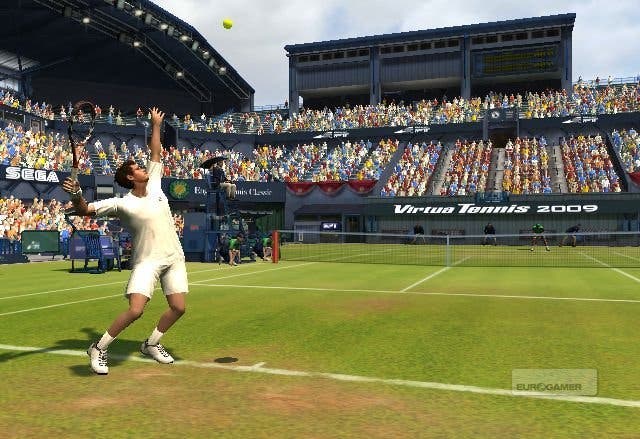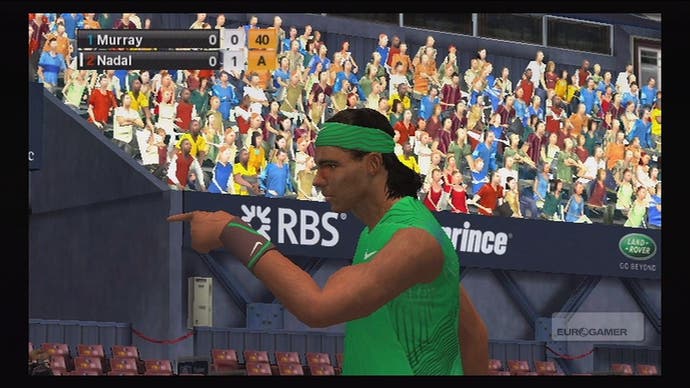Virtua Tennis 2009
Motion granted.
This is an amended version of a review first published last week, then withdrawn by the editor due to errors affecting our previous review of its main competitor, Grand Slam Tennis. Please see the Editor's blog for an explanation.
Thanks to the release of the Wii MotionPlus, tennis games suddenly find themselves the centre of attention as gamers try to establish the merits of Nintendo's new controller add-on. EA Sports' Grand Slam Tennis got the ball rolling, and now it's SEGA's turn to get us leaping around the living room in the name of science.
As you'll recall, Virtua Tennis 2009 was released a few weeks back on PS3 and Xbox 360, and proved to be a solid update to the series with an improved online mode. On the downside, the wearily unchallenging World Tour mode was a little disappointing, as were the curious player progression mechanics and generally lacklustre visuals. Bolting on motion controls might help inject some life into the series - or could just derail it entirely.
As will be the case for many MotionPlus-enabled games, there are essentially two contrasting ways to play. The non-WMP version works on the basis of timing your Wii remote strokes with an on-screen shot gauge, which appears above the player whenever the ball is served or returned to you. Depending on your player's court position, the white vertical line will sweep quickly from either the right or left to represent a forehand or backhand shot.
Similar to the system used in Grand Slam Tennis, shot placement depends on how early or late you return the ball, and the shot gauge provides a handy illustration, sweeping from right to left for a forehand shot and left to right for a backhand, similar to Gears of War's Active Reload system, oddly. To place the shot to the right of the court, you would aim to connect with the ball with the indicator over at the right side of the bar, and vice versa. If you swing too early or too late you'll either miss the shot or hit the ball out. Running, meanwhile, can either be left up to the AI to determine, or you can plug in a nunchuk and try and combine motion control with a control stick tethered - not the most elegant operation as it turns out.

In terms of pulling off specific types of shot, it's a mixture of timing, the angle of the controller and the force you apply. For example, drop shots and slices can be pulled off by tilting the remote upward and swinging in a downward motion with varying degrees of force, while smashing appropriately involves whacking the Wii remote downwards when the opportunity arises - usually near the net. Finally, lob shots can be pulled off by swinging the Wii remote upwards while holding down the A button.
Compared with the standard joypad controls featured on the original versions, the motion-enabled controls take a fair bit of getting used to. Judging when to begin your swing is all-important, as is sussing out how much force to apply on the shot. Fortunately, unlike Grand Slam Tennis, a thorough tutorial mode gives you a run through all manner of shots, from beginner to intermediate and advanced, and leaves you reasonably well-prepared.

Nevertheless, the relative ease of the coaching session contrasts markedly with real matches, with even the lowest-ranked players in World Tour mode seemingly capable of blasting the ball back at velocities which give you a small window within which to get your return in. While the standard joypad controls would allow you a fair margin to return even the most violent shots, trying to respond to a fast shot with Wii motion controls is a comparatively tough task, mainly due to the relative speed with which the shot gauge can move.
As in real life, the faster the ball is coming towards you, the less time you have to react, and while this feels like a perfectly fair reflection of the real game, it's a surprisingly steep learning curve for a new control system. The main problem, of course, is that it's hard to know exactly when to wind up your shot - especially when the game can misread your hand movements at crucial moments. In general, while the addition of motion control is a fun way to play an old favourite, the lack of precision turns an intuitive, flowing game into an unnecessarily frustrating affair that makes you hanker after a control pad before long.


